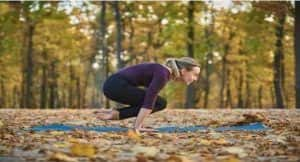Don’t Miss Out on the Latest Updates.
Subscribe to Our Newsletter Today!
Lolasana (Pendant Pose): How To Practice, Benefits And Precautions

Pendant Pose: Modifications And Tips To Perform Lolasana
Lolasana (pendant pose) health benefits: Different names know Lolasana in various yoga schools and how it can be done. In this article, we will describe the pose with the legs in Padmasana. Lolasana comes from the Sanskrit words "Lol", which means "dangling", and asana means "posture" or "form". So, it is also called the "swinging pose". Lolasana is a hand-balancing asana and is part of many intermediate-level Hatha yoga "core" asana practice sessions. To practise this asana, one should be able to sit in Padmasana (the Lotus posture) without any discomfort. Senior Yoga Teacher Sangeeta Padmanabhan, Heartfulness Yoga Academy, shares a step-by-step guide to pendant pose (lolasana).
How To Practice Lolasana?
1. The starting point for Lolasana is Padmasana - the Lotus pose. If you cannot sit in Padmasana, you can do this pose sitting in Sukhasana or with your legs crossed at the ankles.
2. Besides the thighs, place the palms on the floor. If you need to, you could put them on blocks so the whole body can be lifted, pulling the legs to the core. But, again, be aware of your body and choose the variation which works for you.
3. Inhale, press the hands to the floor, engage the abdominal muscles and lift the body.
4. Swing the body gently backwards and forward between your arms.
6. Exhale, slowly lower down to the floor.
7. Repeat the pose with the legs crossed the other way.
Benefits Of Lolasana
1. Strengthens the arms, wrists, and shoulders.
2. Builds upper body strength and core strength.
3. It generates control, coordination and agility.
4. Improves focus.
5. Boosts energy in the body.
6. Regular Practice will develop strong shoulders for inversions and deeper arm balances.
Precautions:This is an intermediate-level practice. People suffering from wrist injuries, shoulder pain, and neck problems should avoid the exercise or do it under an experienced yoga teacher's guidance.



